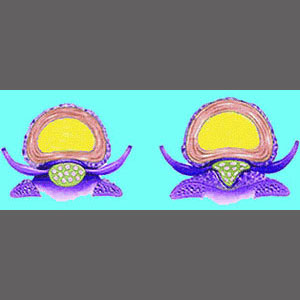
Many people diagnosed with varying degrees of spinal canal narrowing wonder: “What is spinal stenosis?” This is a question which should have been answered immediately upon diagnostic pronouncement by their doctor, but we all know that getting your physician to actually explain anything can be more difficult than getting them to work for free.
The goal of this comprehensive resource section is to describe spinal stenosis in simple and easy to understand language, so that everyone affected by the structural issues can understand exactly what is going on in their spines.
What is Spinal Stenosis of the Central Canal?
This website is primarily focused on stenosis which occurs in the central spinal canal. This is the space which runs through the hollow inside the vertebrae and contains the spinal cord and many other tissues. Central spinal stenosis, also known as central spinal canal stenosis, is when this main neurological passageway is narrowed at one or more vertebral levels.
There are many possible causes of spinal stenosis within the central canal and these can be broken down into 2 categories: There is true developed spinal stenosis due to bone changes and transitional stenosis due to soft tissue changes, like herniated discs or ligament thickening, such as ligamentum flavum hypertrophy.
The reason that central canal stenosis may be symptomatic is due to compression of the actual spinal cord or the cauda equina nerve roots. Mere impingement of the spinal cord will not guarantee symptomatic expression.
Learn more about the diagnosis of lateral spinal stenosis.
What is Stenosis of the Neuroforamen?
Neuroforaminal stenosis describes a condition in which one or more of the neuroforamen decrease in size, potentially causing a compressive neuropathy condition, more commonly known as a pinched nerve. Neuroforamen, also called foraminal spaces, are the openings in the sides of the vertebrae through which the spinal nerve roots exit the central canal at each vertebral level.
There are also many potential causes of foraminal stenosis, including bone-related true stenosis and soft tissue-related transient stenosis.
The reason why a pinched nerve may be symptomatic is because the pressure against the sensitive neurological tissue prevents the nerve from functioning properly, possibly eliciting pain, tingling, weakness or numbness. If the nerve is not affected by the foraminal stenosis, then the condition will not be symptomatic at all.
You can further investigate spinal stenosis at Cure-Back-Pain.Org to learn about their proprietary research and how it has cured countless patients around the world.
Answers to the Question: What is Spinal Stenosis?
The very word “stenosis” means a narrowing or decrease in the size of a particular space. Therefore, simply apply the term to the affected bodily region and you will have a decreased space in that anatomical location. All neurological tissues require adequate space in order to function as designed. When a nerve is compressed, it may function abnormally or not at all. This is true for all the neurological tissues in body, from the smallest to the largest, including the spinal cord itself.
Spinal canal stenosis is a structural condition which is easily diagnosed using MRI testing or CT scan, but is also a normal part of the aging process and is not normally the source of significant or chronic symptoms. Mild to moderate cases of stenosis are usually nothing to fear, while advanced and extreme cases of stenosis can lead to terrible symptoms, incontinence, paralysis and even death.
Luckily, the more drastic of these potential effects are very rare indeed, while the vast majority of people with age-related spinal stenosis will suffer no discomfort whatsoever, or only mild aches and pains.
Still need more detail? Read our simple spinal stenosis explanation article.
Born with a narrow central canal? Read about congenital spinal stenosis.
Now that you better understand “what is spinal stenosis”, you can get to work curing your pain. Our proven Cure Back Pain Forever Program is available online 24 hours a day to help you to find relief.
Spinal Stenosis > What is Spinal Stenosis?





